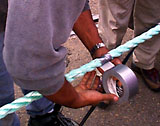
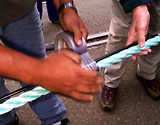
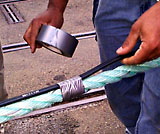
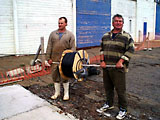
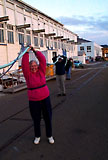 Last night as the sun began to set behind King's Wharf, a group of
people among which were found a television producer and film maker, a few
Ph.D. scientists, a couple of submarine pilots, a ship's captain, first mate,
engineer and deckhand, plus a few others who had equally diverse backgrounds,
all came together to work on taping nearly half a mile of fiber optic cables to a
thick hunk of rope with more rolls of duct tape than I have ever seen in my life.
While there was much discussion as to the proper way to stretch the rope, the
proper spacing of the wraps of duct tape, the best way to coil the line after
it had been taped and many other important topics, the wind began to strengthen
and the air temperature started to plummet. Those of us who had dressed for
"summer in New Zealand" were rudely reminded of the fact that the next land
mass to the south of New Zealand is Antarctica. To put it bluntly, it was downright freezing!
Consequently, I was thankful when the sun dropped behind the hills to the
west and it was decided that it would be best to finish the job the following morning.
When we counted up how many 30 meter marks we had gone through, we were
all very glad to see that we had finished nearly one third of the job by the time
we called it a night.
Last night as the sun began to set behind King's Wharf, a group of
people among which were found a television producer and film maker, a few
Ph.D. scientists, a couple of submarine pilots, a ship's captain, first mate,
engineer and deckhand, plus a few others who had equally diverse backgrounds,
all came together to work on taping nearly half a mile of fiber optic cables to a
thick hunk of rope with more rolls of duct tape than I have ever seen in my life.
While there was much discussion as to the proper way to stretch the rope, the
proper spacing of the wraps of duct tape, the best way to coil the line after
it had been taped and many other important topics, the wind began to strengthen
and the air temperature started to plummet. Those of us who had dressed for
"summer in New Zealand" were rudely reminded of the fact that the next land
mass to the south of New Zealand is Antarctica. To put it bluntly, it was downright freezing!
Consequently, I was thankful when the sun dropped behind the hills to the
west and it was decided that it would be best to finish the job the following morning.
When we counted up how many 30 meter marks we had gone through, we were
all very glad to see that we had finished nearly one third of the job by the time
we called it a night.



So this morning we all reassembled on the wharf bright and early and started the process all over again. You may think that it would be a very simple and straightforward procedure to duct tape what were essentially three pieces of "rope" together, but in reality it took a great deal of learning on our part and much practice before we were comfortable with the process. The first thing we needed to learn was how to tape the fiber optic cables (there were two of them) to the blue poly-steel line. With the "taper" standing on one side of the line and the fiber cable holder (hereafter referred to as the "tapee") standing on the other, the taper wrapped three turns of duct tape around the poly-steel line. Then, the taper carefully held the fiber against the poly-steel making sure to leave a little bit of slack in the fiber. This procedure was practiced a few times by each team of taper and tapee until the two were working in unison.
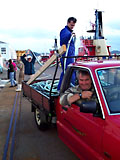
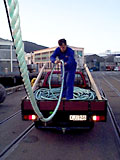 Now that we had the taping well understood, we were ready for the real thing. The end of the poly-steel
was attached by a rolling hitch (taught to us by the skipper and first mate) to the bumper of a little
red pickup truck which slowly drove down the wharf dragging 30 meters of line behind it. Two or
three people stood at 10-15 meter intervals holding the fiber cables aloft so that they wouldn't
be dragged across the rough concrete of the wharf and abrade the thin outer covering of the fibers.
When the truck reached the end of its rope, another rolling hitch was used to anchor the other end to
a large cable spool. Now that both ends were secured, the truck moved forward again just enough to
put some tension on the line and stretch it a bit. Since the weight of the Deep Rover (4 tons) would
stretch the line in case any strain were to be put on it, it was necessary to add some slack to the line when
we taped on the fiber so that it wouldn't snap under tension. Once the truck had stretched the line and
the parking brake applied, the taping teams jumped into action, leap-frogging one past the other in a race to
see who would be the first one to finish their allotment of wraps. I won't go into the details but I will say
that I have seen many an Olympic event that didn't have nearly the drama and competitive spirit that
this one did.
Now that we had the taping well understood, we were ready for the real thing. The end of the poly-steel
was attached by a rolling hitch (taught to us by the skipper and first mate) to the bumper of a little
red pickup truck which slowly drove down the wharf dragging 30 meters of line behind it. Two or
three people stood at 10-15 meter intervals holding the fiber cables aloft so that they wouldn't
be dragged across the rough concrete of the wharf and abrade the thin outer covering of the fibers.
When the truck reached the end of its rope, another rolling hitch was used to anchor the other end to
a large cable spool. Now that both ends were secured, the truck moved forward again just enough to
put some tension on the line and stretch it a bit. Since the weight of the Deep Rover (4 tons) would
stretch the line in case any strain were to be put on it, it was necessary to add some slack to the line when
we taped on the fiber so that it wouldn't snap under tension. Once the truck had stretched the line and
the parking brake applied, the taping teams jumped into action, leap-frogging one past the other in a race to
see who would be the first one to finish their allotment of wraps. I won't go into the details but I will say
that I have seen many an Olympic event that didn't have nearly the drama and competitive spirit that
this one did.
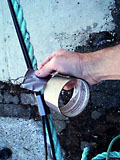
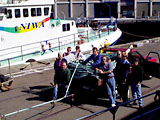 After this 30 meters of line was completed (a duct tape wrap was done every 3 meters or so),
the truck would slowly go in reverse back down the dock, retracing the path it had just travelled while
one person stood in the bed of the truck and very carefully coiled the line with the fiber optic
cables attached into a large coil. People stood along the line and held it aloft so that it could more
easily be placed in the truck. When all the line for this segment had been coiled, the process was
repeated over and over again until finally, after what seemed like an eternity we saw the end of
the line slowly snaking its way up the dock with each successive pull. The last 30 meters was stretched,
the tapers got into position and the final heat of the afternoon was underway. It was neck and neck for
the first 10 meters or so but then the joint US/New Zealand team broke into the lead until finally, standing
at the finish line and holding an empty roll of duct tape in my hand, I looked around and saw that we
had finished. It was almost too much to believe that the last wrap of the last pull was done with the
very last piece of tape on the roll but that was exactly how it came to pass. Standing back and looking
over what we had all done, the coiling gang happily posed for a group photograph.
After this 30 meters of line was completed (a duct tape wrap was done every 3 meters or so),
the truck would slowly go in reverse back down the dock, retracing the path it had just travelled while
one person stood in the bed of the truck and very carefully coiled the line with the fiber optic
cables attached into a large coil. People stood along the line and held it aloft so that it could more
easily be placed in the truck. When all the line for this segment had been coiled, the process was
repeated over and over again until finally, after what seemed like an eternity we saw the end of
the line slowly snaking its way up the dock with each successive pull. The last 30 meters was stretched,
the tapers got into position and the final heat of the afternoon was underway. It was neck and neck for
the first 10 meters or so but then the joint US/New Zealand team broke into the lead until finally, standing
at the finish line and holding an empty roll of duct tape in my hand, I looked around and saw that we
had finished. It was almost too much to believe that the last wrap of the last pull was done with the
very last piece of tape on the roll but that was exactly how it came to pass. Standing back and looking
over what we had all done, the coiling gang happily posed for a group photograph.
If all goes as planned, Ingrid, Clyde, Mike Sweeney and myself will be getting on the ferry tomorrow morning to make the three hour trip across Cook Strait and then the three hour drive down along the east coast of the South Island of New Zealand towards Kaikoura and the site of the expedition in Search of the Giant Squid.
best regards,
gene